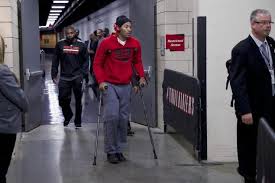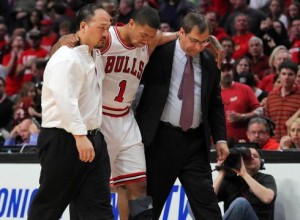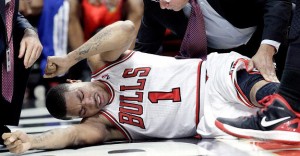Basketball is a well-known contact sport and there is no mandatory padding. As players get into position, the subtle collisions and bumps that happen can allow for injuries that affect just about every part of the body. This means that almost all bones, muscles, ligaments, and joints are at risk for injuries, just like with most other contact sports.
Ankle Sprains
Ankle sprains happen when the ankle is turned in, rolled, or twisted in an abnormal way and results in the tearing or stretching of one of the ligaments in the ankle. This injury is followed by swelling and pain and this can limit range of motion for at least a week. Depending on how severe the injury is, it can take a few months to properly heal. Treatment for a sprained ankle involves the RICE protocol to help with the swelling and the health of the damaged ligament. In some more severe cases, an orthopedic ankle and foot specialist can recommend you do physical therapy in order to make sure that ligaments are healed. To best prevent a sprained ankle, you need to use proper equipment when playing, which includes the right shoes to support the ankle. If you are prone to injuries in this area, then taping or wearing braces may be necessary.
Thigh Bruising
A deep thigh bruise is common in basketball and happens when a knee or elbow strikes a thigh muscle. These bruises can take up to eight weeks to heal, depending on the severity. Treatment involves the RICE method and it’s necessary to make sure the affected area is well rested before you get back to the game. Prevention for this injury can be difficult since the injury happens due to the nature of the game. Shorts with padding or compression sleeves may be worn to lessen the effects of an elbow or knee to the area.
Jammed Fingers
Basketball players get jammed fingers when the ball hits the top of the finger. This jams the finger into the joints and results in swelling and pain. Treatment for a jammed finger involves tape and ice. Icing the finger gives relief and then using tape to align the injured finger with the one next to it can provide balance and protection as it recovers. In order to prevent a jammed finger, you need to be aware. You also need to be ready for the ball and have an understanding of how it moves so you can make sure you don’t get your finger caught.
Knee Injuries
Knee injuries are not as common as other injuries in basketball, as they are with other contact sports, but they can still happen. These injuries range from just some joint pain to more serious injuries, such as torn ligaments or fractures. Serious injuries, such as ACL tears, have also been known to keep players away from the game for years. Treatment will depend on the injury. Joint pain can also be treated with RICE, just like ankle sprains, but more serious injuries require attention from a specialist. Current techniques that are used to repair the ACL will typically allow a player to return to the game the next season. Preventing injuries will come down to flexibility and preparation. In order to prevent a leg and pelvis injury, you need to have muscle balance and proper mechanics to prepare your body for unusual movements that happen during the game. A knee brace or compression sleeve may also help.
Face and Head Injuries
Bumping heads with another player or even taking an accidental elbow aren’t great situations but they can happen with this contact sport. It’s even possible to get hit in the face with the ball. Treatment will depend on the injury but it’s necessary to watch out for concussion symptoms. There isn’t much you can do to avoid this type of injury, but you should monitor symptoms. If you do have symptoms of a concussion, then you need to seek help from a medical professional. If the face injury requires stitches, then ice may provide pain relief and also help with swelling.
Stress Fractures
Stress fractures happen when there is a quick increase in training or activity level. The stress fractures most common in basketball are in the lower leg or foot. Once diagnosed there needs to be a period of non-weight bearing and immobilization. A player can return to the game once the fracture has healed completely and there is no more pain.
To prevent the most common injuries in basketball, it’s necessary to maintain proper fitness. Injury rates are higher for those who haven’t physically prepared for the game. After some inactivity, to get back to the sport you should do some agility training, strength training, and aerobic conditioning. In order to avoid overuse injuries, know that more is not always better. You may need to take some time off each year and not overtrain. Decrease intensity and training time if discomfort or pain develop. If playing outside, pay attention to the environment, especially in humid or hot weather, and hydrate properly



